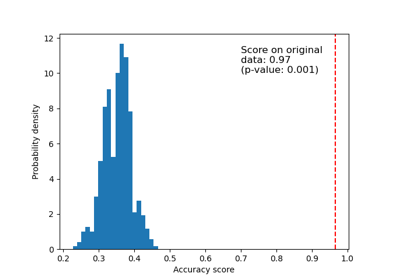permutation_test_score#
- sklearn.model_selection.permutation_test_score(estimator, X, y, *, groups=None, cv=None, n_permutations=100, n_jobs=None, random_state=0, verbose=0, scoring=None, fit_params=None, params=None)[source]#
Evaluate the significance of a cross-validated score with permutations.
Permutes targets to generate ‘randomized data’ and compute the empirical p-value against the null hypothesis that features and targets are independent.
The p-value represents the fraction of randomized data sets where the estimator performed as well or better than in the original data. A small p-value suggests that there is a real dependency between features and targets which has been used by the estimator to give good predictions. A large p-value may be due to lack of real dependency between features and targets or the estimator was not able to use the dependency to give good predictions.
Read more in the User Guide.
- Parameters:
- estimatorestimator object implementing ‘fit’
The object to use to fit the data.
- Xarray-like of shape at least 2D
The data to fit.
- yarray-like of shape (n_samples,) or (n_samples, n_outputs) or None
The target variable to try to predict in the case of supervised learning.
- groupsarray-like of shape (n_samples,), default=None
Labels to constrain permutation within groups, i.e.
yvalues are permuted among samples with the same group identifier. When not specified,yvalues are permuted among all samples.When a grouped cross-validator is used, the group labels are also passed on to the
splitmethod of the cross-validator. The cross-validator uses them for grouping the samples while splitting the dataset into train/test set.Changed in version 1.6:
groupscan only be passed if metadata routing is not enabled viasklearn.set_config(enable_metadata_routing=True). When routing is enabled, passgroupsalongside other metadata via theparamsargument instead. E.g.:permutation_test_score(..., params={'groups': groups}).- cvint, cross-validation generator or an iterable, default=None
Determines the cross-validation splitting strategy. Possible inputs for cv are:
None, to use the default 5-fold cross validation,int, to specify the number of folds in a
(Stratified)KFold,An iterable yielding (train, test) splits as arrays of indices.
For
int/Noneinputs, if the estimator is a classifier andyis either binary or multiclass,StratifiedKFoldis used. In all other cases,KFoldis used. These splitters are instantiated withshuffle=Falseso the splits will be the same across calls.Refer User Guide for the various cross-validation strategies that can be used here.
Changed in version 0.22:
cvdefault value ifNonechanged from 3-fold to 5-fold.- n_permutationsint, default=100
Number of times to permute
y.- n_jobsint, default=None
Number of jobs to run in parallel. Training the estimator and computing the cross-validated score are parallelized over the permutations.
Nonemeans 1 unless in ajoblib.parallel_backendcontext.-1means using all processors. See Glossary for more details.- random_stateint, RandomState instance or None, default=0
Pass an int for reproducible output for permutation of
yvalues among samples. See Glossary.- verboseint, default=0
The verbosity level.
- scoringstr or callable, default=None
A single str (see The scoring parameter: defining model evaluation rules) or a callable (see Callable scorers) to evaluate the predictions on the test set.
If
Nonethe estimator’s score method is used.- fit_paramsdict, default=None
Parameters to pass to the fit method of the estimator.
Deprecated since version 1.6: This parameter is deprecated and will be removed in version 1.6. Use
paramsinstead.- paramsdict, default=None
Parameters to pass to the
fitmethod of the estimator, the scorer and the cv splitter.If
enable_metadata_routing=False(default): Parameters directly passed to thefitmethod of the estimator.If
enable_metadata_routing=True: Parameters safely routed to thefitmethod of the estimator,cvobject andscorer. See Metadata Routing User Guide for more details.
Added in version 1.6.
- Returns:
- scorefloat
The true score without permuting targets.
- permutation_scoresarray of shape (n_permutations,)
The scores obtained for each permutations.
- pvaluefloat
The p-value, which approximates the probability that the score would be obtained by chance. This is calculated as:
(C + 1) / (n_permutations + 1)Where C is the number of permutations whose score >= the true score.
The best possible p-value is 1/(n_permutations + 1), the worst is 1.0.
Notes
This function implements Test 1 in:
Ojala and Garriga. Permutation Tests for Studying Classifier Performance. The Journal of Machine Learning Research (2010) vol. 11
Examples
>>> from sklearn.datasets import make_classification >>> from sklearn.linear_model import LogisticRegression >>> from sklearn.model_selection import permutation_test_score >>> X, y = make_classification(random_state=0) >>> estimator = LogisticRegression() >>> score, permutation_scores, pvalue = permutation_test_score( ... estimator, X, y, random_state=0 ... ) >>> print(f"Original Score: {score:.3f}") Original Score: 0.810 >>> print( ... f"Permutation Scores: {permutation_scores.mean():.3f} +/- " ... f"{permutation_scores.std():.3f}" ... ) Permutation Scores: 0.505 +/- 0.057 >>> print(f"P-value: {pvalue:.3f}") P-value: 0.010
Gallery examples#

Test with permutations the significance of a classification score
